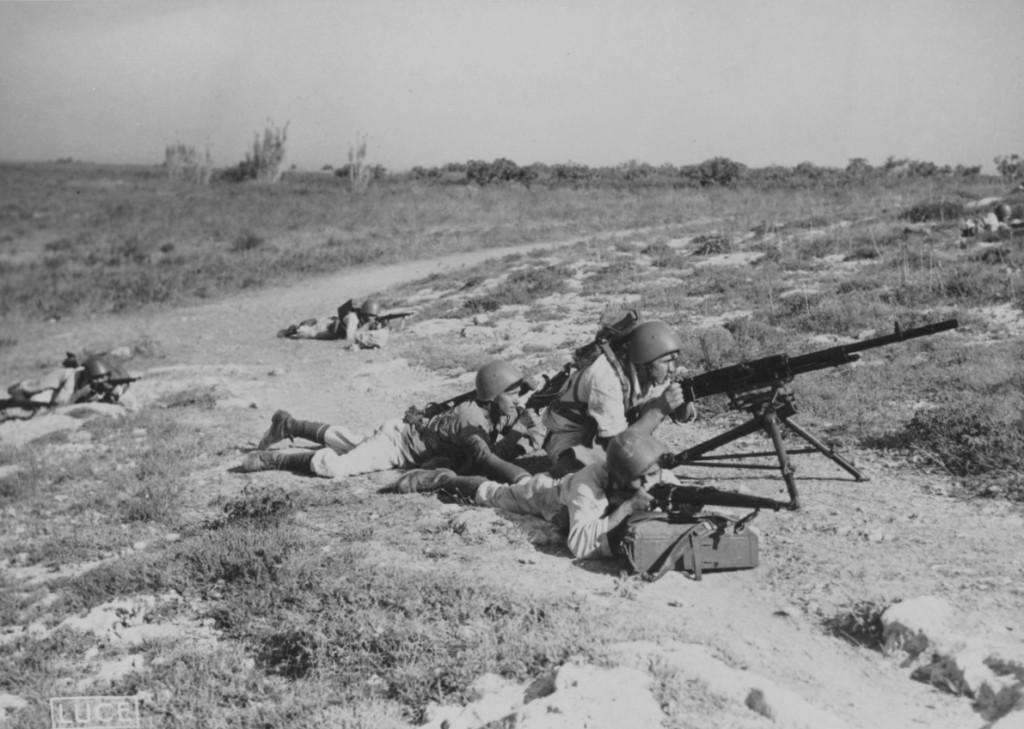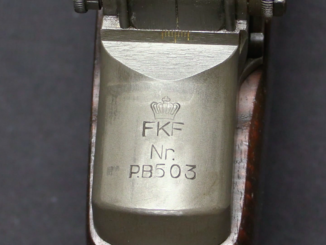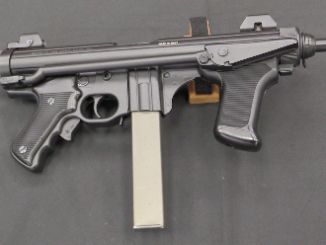 Italian marines at Sitia, on the east end of Crete, armed with M38 Carcano rifles and an M37 Breda heavy machine gun.
Italian marines at Sitia, on the east end of Crete, armed with M38 Carcano rifles and an M37 Breda heavy machine gun.
Related Articles

Semiauto Rifles
Danish Gevaer m/50 – An American Gun Made in Italy
Dozens of countries around the world received M1 Garand rifles from the United States in the decades after World War Two, and Denmark was one of those that not only got some rifle but went […]

Submachine Guns
The Beretta PM-12S Submachine Gun
For several decades, the Beretta company’s handguns and submachine guns were nearly all designed by the very talented Tulio Marengoni…but nothing can last forever. After World War 2, Beretta engineer Domenico Salza began working on […]

Artillery
A 75mm Maxim-Nordenfelt Cannon and the Type 30 Arisaka
First up, a 75mm Maxim-Nordenfelt cannon that was on display at the Carabinieri Museum in Rome. Guns like this one were pretty widely used by countries all over the world, with a wide variety of details […]

Ha,ha,ha, love you Ian.Sitia was the LZ of the italian marines. After heavy fight against heavily armed lokal chikens and donkeys they reached to the center of the town.There a lot of photos with cv-33 and marines walking carefully for the LUCE cameras.As you know chikens poo everywear.
Cool, nothing I’ve read about the Crete invasion mentioned Italians joining in. Go figure.
What is on the machine gunner’s back?
Cardboard boxes of feed strips for the HMG, I believe.
cheers
eon
Sounds more like a practical joke.
Italians landing in Crete ????????????????????
No way .
Germans yes , and with heavy casualties , but Italians ???
Ian , should you ever visit Grecce ,go see the German
military cemetery at the Maleme airport.
italians did land in crete. it was not on the history books, the british did not write it in. they landed after the british had desided to leave 1941.
Spare barrels.
One way or the other, this is definitely a posed photo-op, as evinced by the line of rifleman to the rear of the MG position as well as the fact that the assistant gunner is out of the normal position he is supposed to be in beside the Breda, ready to reload fresh ammunition strips. The gunner himself is in a distinctly uncomfortable ergonomic position that would seem to nullify any concept of properly-aimed fire.
Most “action” photos are posed. Don’t expect tired troopers to aim for veracity. Give the journalist his photos then go grab chow.
The landing, in Sitia Gulf, was on 16:50, and there was no enemy reaction. At 17:20 the landing was complete.
The task force were 102 officiers, 157 NCO and 2323 troops.
Heavy armament was 46/Fiat MG in 8mm, 6/81mm mortars, 18/45 mm mortars, 6/cannons 65\17, 6 cannons 47\32, 13/CV33 light tanks.
Transport were issued by 3 auto, 1 light truck, 9 motorcycles and 205 mules.
The Task Force named Regina.
Ships involved in the mission were:
– 4 fishering ships, requested, named S.Antonio, Navigatore, S.Giorgio, Plutone
– 2 small steamships, Giorgio Orsini (470 tons) and Tarquinia (749 tons)
– 1 river boat, Porto di Roma, 470 tons
– 2 reefer ships, Assab (525 t) Addis Abeba (514 t)
– 1 steam ship, Giampaolo
– 2 little tankers
– 2 tugs, Impero e Aguglia
These lads are members of the Italian 9th Infantry Division (1st Bn/9th Infantry Rgt
2nd bn/10th Infantry Rgt, 2 x sailors companies) and no from the San Marco. Were utilized in basic and uneventful garrison duties.
For more fun take a look at http://www.youtube.c…h?v=JuoXDYYPOtk
Hi, Dimitris :
Thanks for the excellent and detailed historical information. It certainly helps to put things in perspective. I’m guessing that Mussolini’s propagandists were trying to make the most of the situation with photo-ops like this ( no doubt accompanied by assorted blood-stirring martial accounts, as is the wont of propagandists of every stripe and nationality throughout history ), probably much to the chagrin and secret embarrassment of the troops on the ground, who had no choice but to go along with the charade although they obviously knew better as far as the hard truth was concerned.
Page cant’ be displayed… Was it loughed out? Man oh man, traditionally brave Italian military…. with all due respect to your knowledge Dmitris, gimme a break please.
Germans had tough enough going and they fought with all the skills they had. I also believe this is staged photo-op, probably made in Sicily.
Reminds me of Coppola’s cameo in “Apocalypse Now.” “Don’t look at the camera…act like you’re fighting…” Dimitris, thanks for the detailed information. Makes Dunkirk and Normandy look like sailing regattas! Those guys were probably thinking, “I hope those Germans took care of business. Nobody knows how to work this damned machinegun.” I wonder if any got wound badges for getting kicked by the donkeys? A good friend of mine’s dad (now deceased) served in the Bersaligheri under Mussolini, and even he made fun of the Italian army in WW2. He loved Mussolini, though. I never could figure that out. Neat old guy, regardless. Shared many a meal and bottle of wine with him, and spent a lot of time fishing with his family. RIP “Pops.”
The theoretical doctrine to ‘fascisti’ movement was developed by people with high degree od insight into social sciences. From what I read the Duce was really quite popular, from beginning. The views he was presenting ware not all that bad. It was working for good part for Italy, as long at it did not start its aggression in Africa and elsewhere. Then population stepped back and dumped the regime. It happened with help of military (gen. Badoglio), one of better uses of Italian military.
According to “Pops,” Mussolini had a lot of personal charisma. He also said, “When Mussolini ran things, everybody had a job, they didn’t have any crime, and all of the trains ran on time.” There was an interesting bit on Mussolini last night in History’s “The World Wars.” Decent show, but don’t get me started on the firearms faux pas’ during the re-enactments, though. It really detracted from the program.
Good observation , Doc. While I certainly don’t agree with Fascism or any sort of totalitarianism of any stripe, period, one must admit that Mussolini did do many good things for Italy, eg., finally bringing the Mafia and the corruption they engendered under control, restoring a modicum of social order out of prior near-anarchy, increasing economic efficiency, plus what you have mentioned, and more. Unfortunately, all this came at a significant price to personal and collective social liberty tainted by the will to power, although I suppose it can be reasonably argued that the human condition is ( nearly always ) such that one cannot make an omelette without first breaking the eggs, so to speak.
Having said that, I do notice that one of the biggest problems with many so-called “historical programmes” is that they have a tendency to become ensconced in altruisms that repeat certain mantras as if they were the be-all and end-all of truth, which is quite understandable given the passage of time, the passing of generations and the inevitable separation of the immediacy of humanity and conflict that results. The end result is, unfortunately, a very skewed presentation of the hard truths of historical fact, and this is being presented — and accepted via media — as actually what happened. Prominent examples that rear their ugly heads again and again are how nearly all German soldiers, sailors and airmen who served during the Second World War are referred to in blanket terms as “Nazis”, and how the Luftwaffe is often spoken of as the “Nazi Air Force”, even though it is a long-established fact that the senior operational commanders and rank-and-file of the Luftwaffe, while obligated to do their duty and choosing to fulfill it as men of honor, were also simultaneously in almost constant rebellion against the political ( Nazi ) establishment, in terms of humanitarian, social, strategic and tactical bases. The only reason why the Nazi-dominated government chose to tolerate this up to a point is because so many of the Luftwaffe’s aces had become folk heroes ( ironically as a result largely of self-serving Nazi propaganda ), because Germany ( and the ultimate fate of the Nazi Party ) could ill-afford to lose the services of experienced and dedicated professionals ( in spite of their obvious political disinclinations ), and because of the emotional and psychological vagaries of the top German leadership ( witness Hermann Goering’s wild mood swings between an overwhelming, almost tender love for his Fleigerkorps vis-a-vis his harsh outbursts against them ; also, even Adolf Hitler, although an old-time “trench rat” who did not forget the horrors of his own time in the front line during the First World War, understood enough about the Luftwaffe and its fighting men to allow them an amazing amount of latitude — considering the political and military circumstances of the time — even as he simultaneously ranted against what he considered their “gross ineptitude” towards the latter half of the Second World War.
Μy apologies for the delay in my response but here in Greece we have elections. I forgot to mention the day of the landing. It was May 27, when most of the allies fled to Middle East.
Indeed, the video for some reason has come down.
There are two theories.
The first says that the scenes was shot during the landing
and the second that was shot in Sicily during testing for the landing in Malta.
Accorting the italian Naval archives the landing take place in 27 May 1941.
Let pray for the souls of all those who died (soldiers and civilians)
All the best to the ‘right’ people – Χρυσή Αυγή !
Anyway, when comes to Greeks as soldiers I must say I have immeasurably higher respect to them than to those mentioned previously. This picture is obviously sham.
BTW I have seen who won. My sincere condolences!
Those chaps would have loved a Bren gun, I reckon.
That Breda, is more Fiat than Ferrari.
You might call it that way if Bren was felt fed. As far as I know they had a prototype (made by Inglis in Toronto, Canada?) which did not go to production. I believe it got stuck some place in England.
Better mag fed than stripper clip fed, particularly when it’s a 30rnd mag compared to a 20rnd feed clip.
A gun that is as big as that Breda should be belt fed, for sure.
Although it says,
http://world.guns.ru/machine/it/breda-m1937-e.html
it had it’s own “more powerful” calibre 8x59mm.
However I doubt that round gave it any advantage over a .303 Bren personally, particularly when lugging it around.
Hmmm,
http://www.ammo-one.com/8mmBredaItalianMachinegun.html
http://en.wikipedia.org/wiki/8%C3%9759mm_RB_Breda
I get the idea sort of a automatic “Laupa magnum” rifle.
There’s a modern belt fed, machine gun in .338 Norma Mag apparently,
http://en.wikipedia.org/wiki/Lightweight_Medium_Machine_Gun
like it.
Must have been of some use though, there are WWII newsreels from the siege of Tobruk showing Australian troops using these Bredas as antiaircraft guns, in the same role as Brens at the time. Other captured Italian weapons were also put to good use.
The 8mm Breda Modello 37 was a heavy (medium by modern standards) machine gun, which fed from rigid strips, Hotchkiss style, rather than from an integral magazine loaded with stripper clips. The one you were thinking about was the 6.5mm Breda Modello 30 LMG, which really was a pretty bad weapon. The Mod. 37 on the other hand was the best Italian MG, fairly reliable, chambered for quite powerful cartridge, and with good overall firepower.
Or much better then a Bren, a MG-34.
To be honest, at Tobruk they were so short of equipment they would have taken the pragmatic view that any MG was a good MG. Plus at that point they had so much Italian ammo it would have made sense to use it to stretch out the .303 they had on hand.
As soon as they could get replacement Brens and Vickers guns the Italian stuff probably went into the Med.
One significant side-note about the Breda 37 was that, by at least some reliable accounts eg., Arthur Swinson in his book “The Raiders : Desert Strike Force” ( Ballantine Books, 1968 ), the LRDG actually preferred the Breda over the Lewis gun on the occasions they could capture it along with sufficient quantities of ammunition, citing better mechanical reliability ( with the exception of the need for oiled cartridges, which required careful attention to detail ) and greater firepower.
I wonder if FW will be able, at some point, to get its hands on a Breda 37 for a little testing? This might yield some interesting results.
I have fired a Breda 37 and got some video, but really not enough to do much with. And the gun’s owner has since passed away – if I have another chance to use one, I will definitely do a more in-depth video of article on it.
just uploaded the footage anyway , it may not be perfect but i would still want to see it
I have fired a Hotchkiss and found that being able to see how many round were available in the strip an advantage.
The MOD Pattern Room had a prototype Bren converted to 7.52 Nato with a belt feed and Vicker’s type spade grips, a very neat looking gun. Unfortunately this never went into production.
Sorry s/b 7.62 Nato